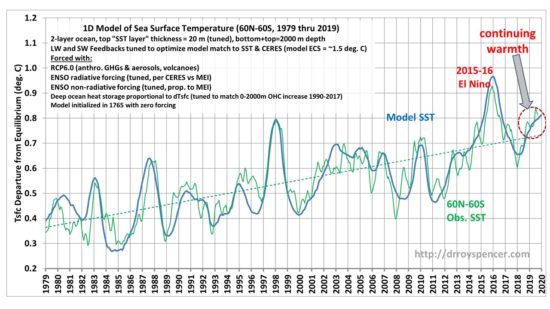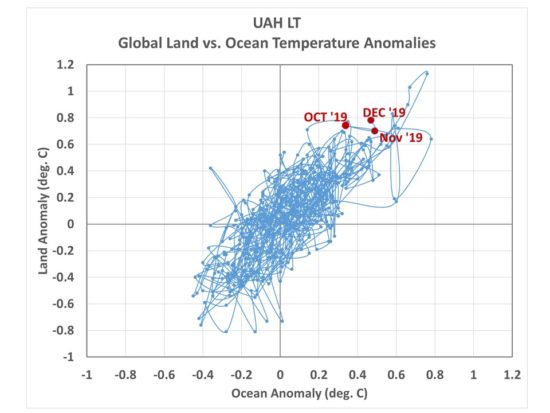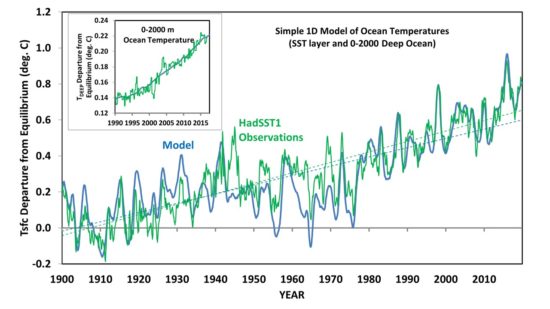The continuing global-average warmth over the last year has caused a few people to ask for my opinion regarding potential explanations. So, I updated the 1D energy budget model I described a couple years ago here with the most recent Multivariate ENSO Index (MEIv2) data. The model is initialized in the year 1765, has two ocean layers, and is forced with the RCP6 radiative forcing scenario and the history of El Nino and La Nina activity since the late 1800s.
The result shows that the global-average (60N-60S) ocean sea surface temperature (SST) data in recent months are well explained as a reflection of continuing weak El Nino conditions, on top of a long-term warming trend.

The model is described in more detail below, but here I have optimized the feedbacks and rate of deep ocean heat storage to match the 41-year warming trend during 1979-2019 and increase in 0-2000m ocean heat content during 1990-2017.
While the existence of a warming trend in the current model is due to increasing CO2 (I use the RCP6 radiative forcing scenario), I agree that natural climate variability is also a possibility, or (in my opinion) some combination of the two. The rate of deep-ocean heat storage since 1990 (see Fig. 3, below) represents only 1 part in 330 of global energy flows in and out of the climate system, and no one knows whether there exists a natural energy balance to that level of accuracy. The IPCC simply *assumes* it exists, and then concludes long-term warming must be due to increasing CO2. The year-to-year fluctuations are mostly the result of the El Nino/La Nina activity as reflected in the MEI index data, plus the 1982 (El Chichon) and 1991 (Pinatubo) major volcanic eruptions.
When I showed this to John Christy, he asked whether the land temperatures have been unusually warm compared to the ocean temperatures (the model only explains ocean temperatures). The following plot shows that for our UAH lower tropospheric (LT) temperature product, the last three months of 2019 are in pretty good agreement with the rest of the post-1979 record, with land typically warming (and cooling) more than the ocean, as would be expected for the difference in heat capacities, and recent months not falling outside that general envelope. The same is true of the surface data (not shown) which I have only through October 2019.

The model performance since 1900 is shown next, along with the fit of the model deep-ocean temperatures to observations since 1990. Note that the warming leading up to the 1940s is captured, which in the model is due to stronger El Nino activity during that time.

The model equilibrium climate sensitivity which provides the best match to the observational data is only 1.54 deg. C, using HadSST1 data. If I use HadSST3 data, the ECS increases to 1.7 deg. C, but the model temperature trends 1880-2019 and 1979-2019 can no longer be made to closely approximate the observations. This suggests that the HadSST1 dataset might be a more accurate record than HadSST3 for multi-decadal temperature variability, although I’m sure other explanations could be envisioned (e.g. errors in the RCP6 radiative forcing, especially from aerosol pollution).
A Brief Review of the 1D Model
The model is not just a simple statistical fit of observed temperatures to RCP6 and El Nino/La Nina data. Instead, it uses the energy budget equation to compute the monthly change in temperature of ocean near-surface layer due to changes in radiative forcing, radiative feedback, and deep-ocean heat storage. As such, each model time step influences the next model time step, which means the model adjustable parameters cannot be optimized by simple statistical regression techniques. Instead, changes are manually made to the adjustable model parameters, the model is run, and then compared to a variety of observations (SST, deep ocean temperatures, and how CERES radiative fluxes vary with the MEI index). Many combinations of model adjustable parameters will give a reasonably good fit to the data, but only within certain bounds.
There are a total of seven adjustable parameters in the model, and five time-dependent datasets whose behavior is explained with various levels of success by the model (HadSST, NODC 0-2000m deep ocean temperature [1990-2017], and the lag-regression coefficients of MEI versus CERES satellite SW, LW, and Net radiative fluxes [March 2000 through April 2019]).
The model is initialized in 1765 (when the RCP6 radiative forcing dataset begins) which is also when the climate system is (for simplicity) assumed to be in energy balance. Given the existence of the Little Ice Age, I realize this is a dubious assumption.
The energy budget model computes the monthly change in temperature (dT/dt) due to the RCP6 radiative forcing scenario (which starts in 1765, W/m2) and the observed history of El Nino and La Nina activity (starting in 1880 from the extended MEI index, intercalibrated with and updated to the present with the newer MEIv2 dataset (W/m2 per MEI value, with a constant of proportionality that is consistent with CERES satellite observations since 2000). As I have discussed before, from CERES satellite radiative budget data we know that El Nino is preceded by energy accumulation in the climate system, mainly increasing solar input from reduced cloudiness, while La Nina experiences the opposite. I use the average of the MEI value in several months after current model time dT/dt computation, which seems to provide good time phasing of the model with the observations.
Also, an energy conserving non-radiative forcing term is included, proportional to MEI at zero time lag, which represents the change in upwelling during El Nino and La Nina, with (for example) top layer warming and deep ocean cooling during El Nino.
A top ocean layer assumed to represent SST is adjusted to maximize agreement with observations for short-term variability, and as the ocean warms above the assumed energy equilibrium value, heat is pumped into the deep ocean (2,000 m depth) at a rate that is adjusted to match recent warming of the deep ocean.
Empirically-adjusted longwave IR and shortwave solar feedback parameters represent how much extra energy is lost to outer space as the system warms. These are adjusted to provide reasonable agreement with CERES-vs.-MEI data during 2000-2019, which are a combination of both forcing and feedback related to El Nino and La Nina.
Generally speaking, changing any one of the adjustable parameters requires changes in one or more of the other parameters in order for the model to remain reasonably close to the variety of observations. There is no one “best” set of parameter choices which gives optimum agreement to the observations. All reasonable choices produce equilibrium climate sensitivities in the range of 1.4 to 1.7 deg. C.

 Home/Blog
Home/Blog



